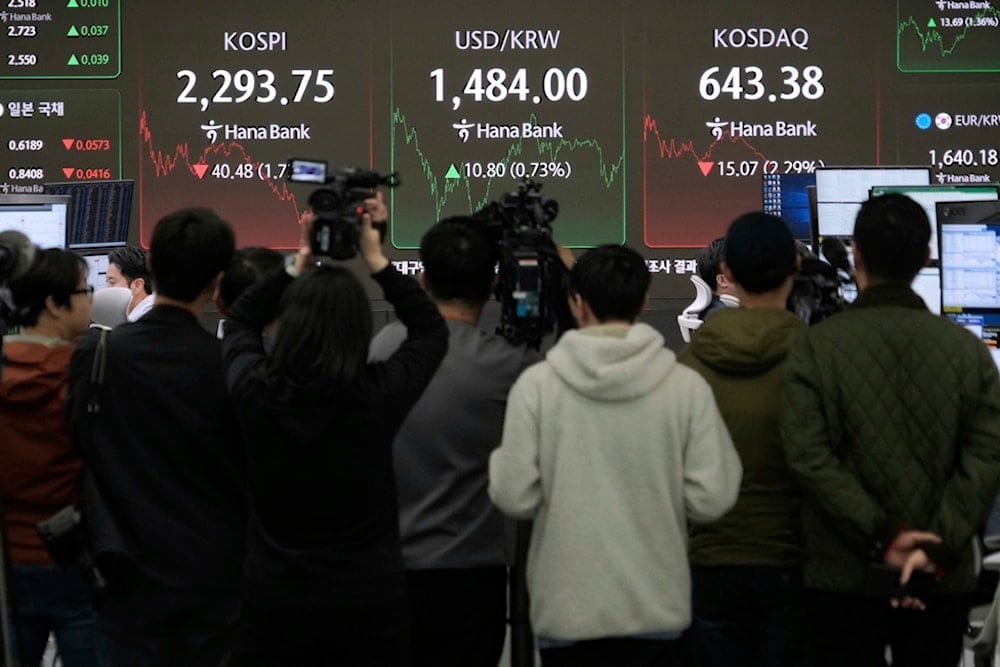US no longer seen as safe haven by global investors: Axios
A historic week of market turmoil has shaken global confidence in the US financial system, as investors sell off both the dollar and Treasury bonds, signaling deepening concerns.
-
 Members of media stand near a screen showing the Korea Composite Stock Price Index (KOSPI), top left, and the foreign exchange rate between U.S. dollar and South Korean won, top center, at the foreign exchange dealing room of the KEB Hana Bank headquarters in Seoul, South Korea, on Wednesday, April 9, 2025 (AP)
Members of media stand near a screen showing the Korea Composite Stock Price Index (KOSPI), top left, and the foreign exchange rate between U.S. dollar and South Korean won, top center, at the foreign exchange dealing room of the KEB Hana Bank headquarters in Seoul, South Korea, on Wednesday, April 9, 2025 (AP)
For generations, US Treasury bonds and other dollar-denominated assets have served as the world’s financial haven, but this week, global investors were confronted with the unsettling realization that these assets may no longer be as safe, nor as reliable, as once believed, Axios reported on Friday.
It emphasized that the events of the past nine days are likely to be remembered as a pivotal moment in economic history, with developments in global trade and financial markets, typically years in the making, unfolding at an unprecedented pace, reshaping expectations daily.
April 2025 may well join the ranks of landmark economic turning points alongside July 1944, August 1971, and September 2008, moments that scholars have studied for decades, the news website added.
It noted that trade policy shifts have been particularly dramatic: the United States and China, the world’s two largest economies, are now imposing tariffs exceeding 100% on each other’s imports. Should this trend persist, it would effectively bring bilateral trade to a halt.
Yet, it is the unusual behavior in bond and currency markets that is raising the gravest concerns about global confidence in the US-led financial system that has dominated since the end of World War II, according to Axios.
In a week marked by sell-offs across equities and other risk assets, US Treasuries and the dollar also declined — an extraordinary and troubling development, the report remarked.
Axios noted that, historically, during periods of severe market turmoil, such as the 2008 financial crisis or the early stages of the COVID-19 pandemic, the dollar rallied as investors sought the safety of US assets.
Those past crises were marked by a global shortage of dollars so acute that the Federal Reserve was forced to step in with emergency measures, including currency swap lines and liquidity support. No such shortage exists today.
Krishna Guha of Evercore ISI considered that this week has seen a "rare, ugly and worrying combination of market moves."
As of 11 am ET on Friday, the yield on the 10-year US Treasury note stood at 4.57%. While not inherently concerning — yields were higher as recently as January — the rapid rise from below 4% just a week earlier is notable and worrisome.
Meanwhile, the US dollar index, which measures the dollar’s performance against six major currencies, has fallen 3.4% since Tuesday and 9.2% since mid-January, a steep decline by the standards of global currency markets.
Axios explained that these moves suggest that growing fiscal imbalances, weakening diplomatic relations, and perceived instability in US leadership are making international investors increasingly cautious about maintaining exposure to the United States.
The market "is re-assessing the structural attractiveness of the dollar as the world's global reserve currency and is undergoing a process of rapid de-dollarization," suggested Deutsche Bank currency strategist George Saravelos.
"Markets can behave weirdly, and maybe this will turn out to be just a few bumpy trading days. But the world's most important financial markets — for the dollar and Treasury securities — are signaling that something fundamental is shifting beneath our feet," Axios indicated.
Read more: US tariffs threaten $2 trillion in global investments: Financial Times

 4 Min Read
4 Min Read










